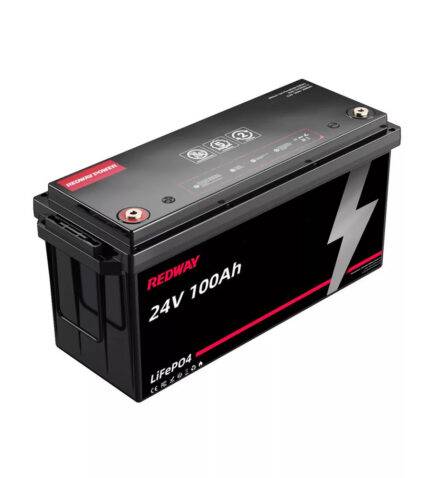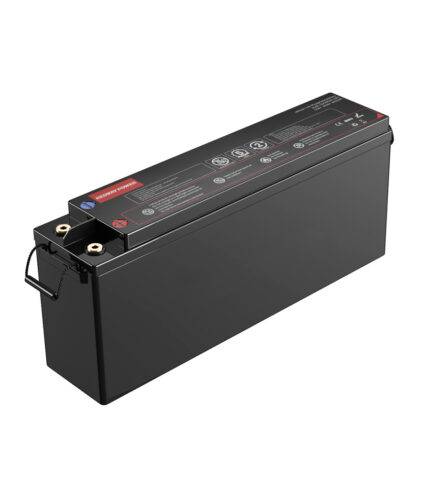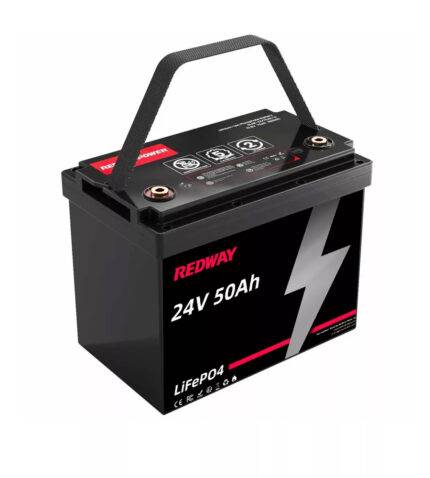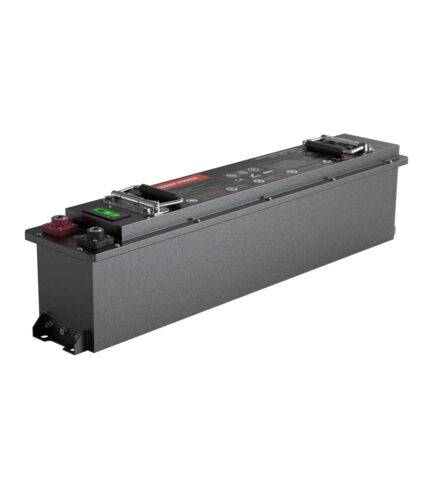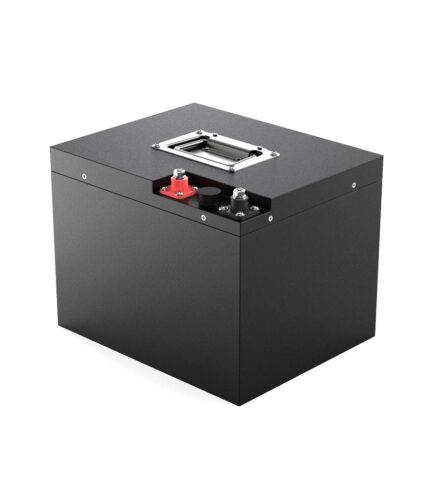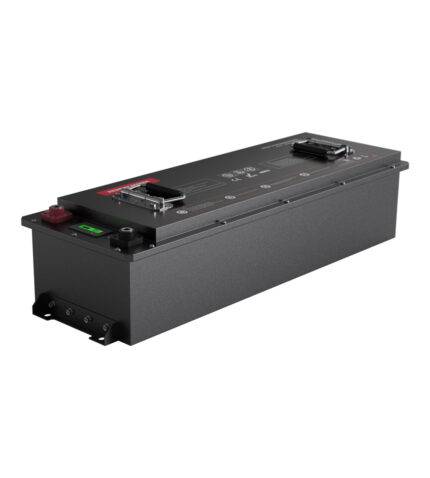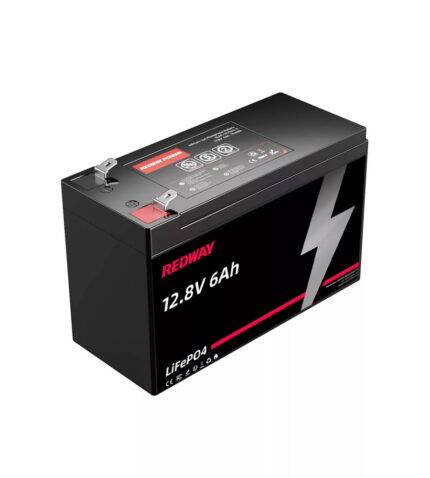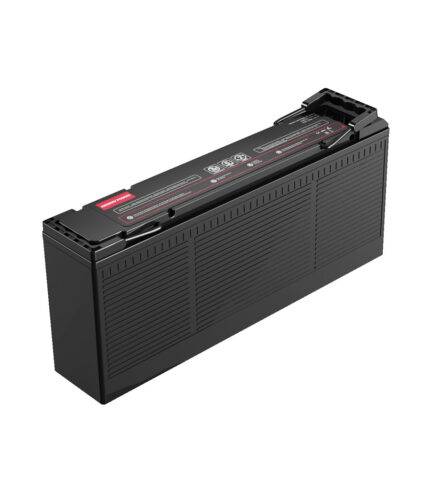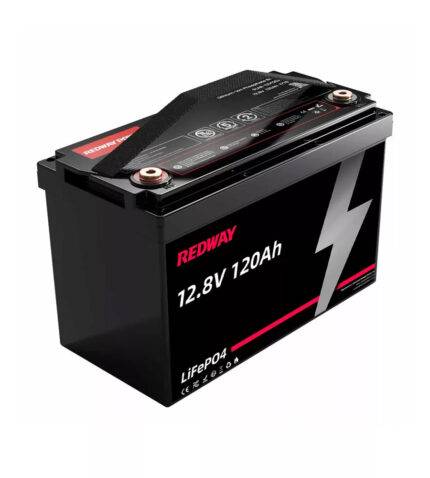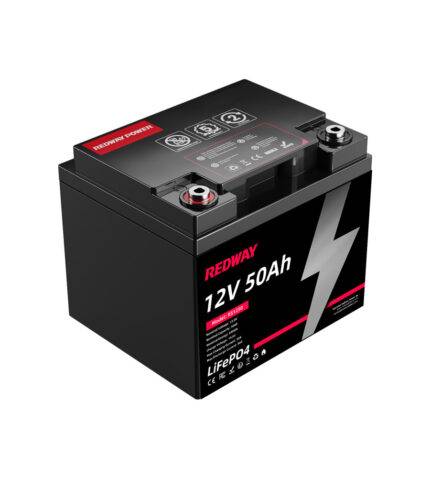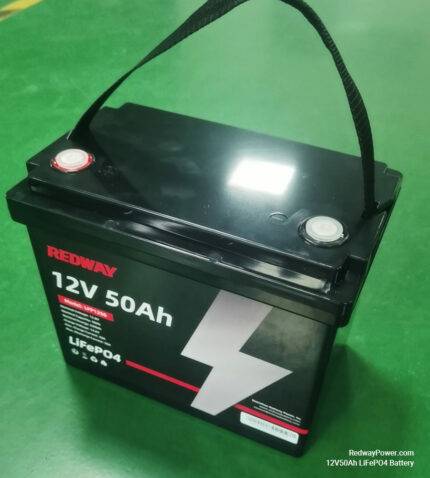| 24V105Ah-EU Thinner | Specifications |
|---|---|
| Cell Type | LiFePO4 |
| Nominal Voltage | 25.6V |
| Nominal Capacity | 105Ah |
| Nominal Energy | 2688Wh |
| Charge Voltage | 29.2V |
| Discharge Voltage | 20V |
| Max. Continues Charge Current | 100A |
| Max. Continues Discharge Current | 100A |
| Dimensions [L x W x H] | 552 x 110 x 288 mm 21.7 x 4.3 x 11.3 in |
| Weight | 21.3 kg 47 lb |
| IP Rating | IP65 (More request) |
| Series & Parallel | 8S1P |
| Max. Battery Parallel | 4P to 10.75kWh (More request) |
| Internal Resistance | ≤30mΩ |
| Cycle Life | >4000 cycles (DOD 80%) |
| Self-Discharge | 3% (Per month) |
| Charge Temperature | 0°C ~ 60°C 32°F ~ 140°F |
| Discharge Temperature | -20°C ~ 65°C -4°F ~ 149°F |
| Optional Functions | Bluetooth / WiFi / LCD / LED Touch Screen / RS485 / RS232 / CAN / 4G, 5G / GPS / APP |
| Charger | High current fast charger |
| BMS | Intelligent BMS protection |
| Terminal | M8 Bolts |
| Battery Case | ABS (Fireproof plastic) |
| Warranty | 3 Years |
| Silk-Screen / Label Printing | Yes |
| User Manual / Warranty Card | Yes |
| Customization / OEM / ODM | Yes |
| Shipment | Yes |
| Certifications | IEC, UN38.3, MSDS (More request) |
24V 105Ah-EU Lithium Battery (Much Thinner)
• Cell: LiFePO4
• MOQ: 50
• Delivery: 20 Days
• Customizable / OEM / ODM: Yes
• Factory: Redway, Dongguan, Guangdong, China
• Delivery Terms: FOB, EXW, CIF
• Payment: T/T, L/C, PayPal
• Sea / Air / Land Shipment: 10FT, 20FT, 40FT, 60FT
Category: 24V Lithium Battery
Tags: 24V, 24V 100Ah, 24V 105Ah, LFP, LiFePO4 Battery, Lithium Battery
Description
Specifications
Download 24V 105Ah-EU (Much Thinner) Datasheet
Note: Our products are customizable, allowing customers to modify the main data according to their requirements.
| 24V105Ah-EU Much Thinner | Specifications |
|---|---|
| Cell Type | LiFePO4 |
| Nominal Voltage | 25.6V |
| Nominal Capacity | 105Ah |
| Nominal Energy | 2688Wh |
| Charge Voltage | 29.2V |
| Discharge Voltage | 20V |
| Max. Continues Charge Current | 100A |
| Max. Continues Discharge Current | 100A |
| Dimensions [L x W x H] | 552 x 110 x 288 mm 21.7 x 4.3 x 11.3 in |
| Weight | 21.3 kg 47 lb |
| IP Rating | IP65 (More request) |
| Series & Parallel | 8S1P |
| Max. Battery Parallel | 4P to 10.75kWh (More request) |
| Internal Resistance | ≤30mΩ |
| Cycle Life | >4000 cycles (DOD 80%) |
| Self-Discharge | 3% (Per month) |
| Charge Temperature | 0°C ~ 60°C 32°F ~ 140°F |
| Discharge Temperature | -20°C ~ 65°C -4°F ~ 149°F |
| Optional Functions | Bluetooth / WiFi / LCD / LED Touch Screen / RS485 / RS232 / CAN / 4G, 5G / GPS / APP |
| Charger | High current fast charger |
| BMS | Intelligent BMS protection |
| Terminal | M8 Bolts |
| Battery Case | ABS (Fireproof plastic) |
| Warranty | 3 Years |
| Silk-Screen / Label Printing | Yes |
| User Manual / Warranty Card | Yes |
| Customization / OEM / ODM | Yes |
| Shipment | Yes |
| Certifications | IEC, UN38.3, MSDS (More request) |
Applications and FAQs
Redway Power's 24V 105Ah-EU LiFePO4 batteries represent a notable advancement over traditional deep cycle batteries, boasting an impressive lifespan of up to 4000 cycles compared to the standard 500 cycles of sealed lead-acid batteries. Tailored for the European market, these batteries prioritize longevity and efficiency. They are well-suited for a variety of applications including home alarm systems, camping, and solar lighting, offering cost-effectiveness and durability to meet the energy demands of European market.
What is 24V 105Ah-EU LiFePO4 Battery?
Redway Power 24V 105Ah-EU (Much Thinner) LiFePO4 battery is specifically crafted for the European market, and this rechargeable powerhouse stands as a notable advancement over traditional deep cycle batteries. Its hallmark feature? Longevity. With a lifespan of up to 4000 cycles, it outlasts standard sealed lead-acid (SLA) batteries, which typically offer around 500 cycles. This robust endurance translates to substantial cost savings per use. Ideal for a myriad of applications including home alarm systems, camping, solar lighting, and renewable energy storage systems, this battery embodies durability and efficiency, making it a top choice for energy-conscious consumers in Europe.

Note: we have 3 versions of 24V 105Ah lithium-ion batteries: Standard, Thinner, Much Thinner.
Comparing LiFePO4 Battery Adoption: Europe vs US
We say that the 24V 105Ah-EU LiFePO4 (Lithium Iron Phosphate) battery is well-suited for both the European and U.S. markets, meaning it is specially designed for EU markets. Let's look at some of the notable differences:
Environmental Concerns and Regulations:
- Europe: Strong emphasis on environmental sustainability and reducing greenhouse gas emissions drives demand for EVs and renewable energy storage systems.
- United States: Environmental awareness is valued, but regulations and incentives for EV adoption may vary by state.
Safety Standards and Certifications:
- Both markets prioritize safety, with the U.S. having specific standards set by organizations like UL. LiFePO4 batteries must meet these standards for safe use.
- European standards like CE also apply to LiFePO4 batteries sold in the EU, ensuring safety compliance.
Cost and Economics:
- LiFePO4 batteries have a lower cost compared to other lithium-ion variants due to less expensive manufacturing materials.
- In the U.S., this cost-effectiveness contributes to their popularity, particularly for home energy storage and EV applications.
Market Competition and Distribution:
- The industry is competitive, with major players in the U.S. and China operating across various locations.
- Manufacturers maintain widespread distribution networks, facilitated by dealers and third-party agencies, ensuring product availability in both markets.
In summary, while the fundamental technology remains the same, regional factors, safety standards, and economic considerations influence the adoption and use of LiFePO4 batteries in Europe and the U.S.
Where can you use a 24V 105Ah-EU battery?
A 24V 105Ah-EU battery finds essential applications across various sectors:
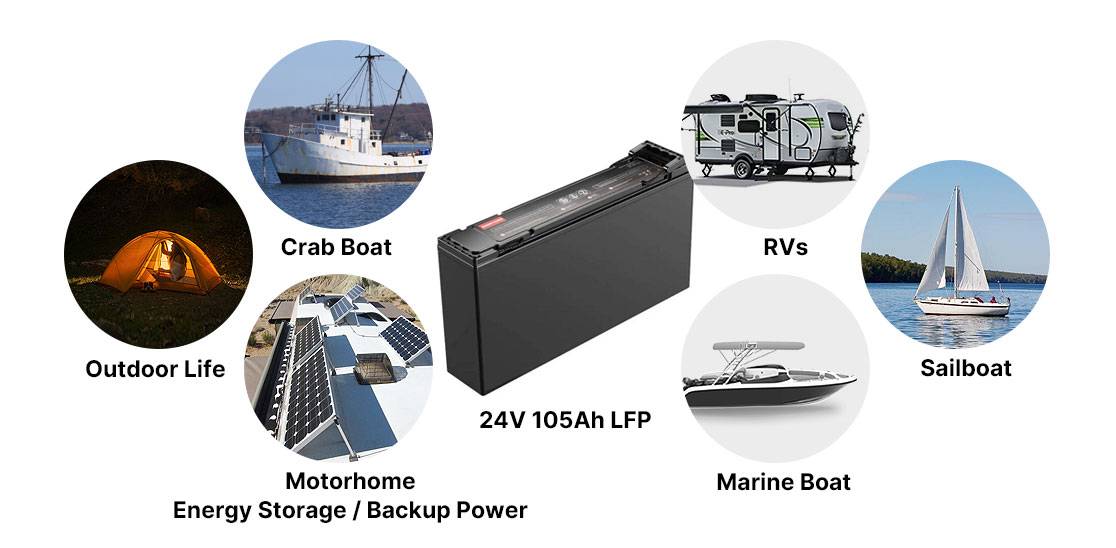
- Off-Grid Solar Power Systems: Stores surplus energy for continuous availability, ensuring reliable power in remote locations.
- Marine and RV Setups: Powers electronics and appliances during extended trips, providing essential energy for comfort and functionality.
- Industrial Settings: Ensures uninterrupted operations and serves as a backup power supply during outages, enhancing productivity and reliability.
- Renewable Energy Storage: Optimizes energy utilization and grid stability, supporting the integration of renewable energy sources.
- Electric Vehicles: With high energy density, enables longer driving ranges and faster charging, enhancing the performance of electric vehicles.
In residential, commercial, and industrial settings, this battery offers reliability, efficiency, and versatility to meet diverse energy needs.
Explain the different advantages of a 24V 105Ah-EU lithium-ion battery?
A 24V 105Ah-EU lithium-ion battery presents a multitude of advantages over traditional lead-acid batteries, making it a preferred choice for various applications. These benefits encompass:
- Versatile Connectivity: These batteries can be connected in parallel and series configurations, allowing for scalability and customization of power systems to meet specific energy requirements. For example, in solar energy systems, multiple batteries can be connected in parallel to increase energy storage capacity as needed.
- No Memory Effect: Users can charge and use the battery at any time without the need for discharging beforehand, ensuring optimal performance and extended device operation on a single charge. This feature is particularly advantageous in applications like electric vehicles, where frequent charging and discharging occur.
- Robust Cycle Life: With a high cycle life of up to 5000 cycles and a five-year warranty (subject to usage frequency), these batteries deliver reliable power output over an extended period, offering consistent performance. This durability makes them suitable for demanding applications such as off-grid solar systems and backup power solutions.
- Higher Energy Density: Despite their lightweight and compact design, lithium-ion batteries provide enhanced power delivery with high current output and increased power storage capacity. For instance, in electric vehicles, lithium-ion batteries offer higher energy density, enabling longer driving ranges and faster acceleration.
- Low Self-Discharge: These batteries exhibit minimal energy loss during storage periods due to their low self-discharge rate, ensuring stored energy remains available when needed. This feature is crucial for backup power applications, where the battery must be ready to provide power at a moment's notice.
- Eco-Friendly: Lithium-ion batteries are non-toxic, acid-free, and safe to use, contributing to environmental sustainability. By utilizing renewable energy sources for power generation and minimizing noise pollution, they serve as eco-friendly energy storage solutions. Additionally, their long lifespan reduces the need for frequent replacements, further reducing environmental impact.
This 24V 105Ah-EU lithium-ion battery offers several advantages, including versatile connectivity, freedom from memory effect, robust cycle life, enhanced energy density, low self-discharge, and eco-friendliness, making it suitable for many applications.
What are the disadvantages of a 24V 105Ah-EU lithium battery?
Despite their numerous advantages, 24V 105Ah-EU lithium batteries also have some drawbacks.
- Higher Initial Cost:One significant drawback is the higher initial cost compared to lead-acid batteries. This expense may deter some users, especially those on tight budgets.
- Potential Degradation:Lithium-ion batteries can degrade if exposed to extreme temperatures or overcharged. Proper management and monitoring systems are necessary to prevent degradation and ensure longevity.
- Safety Concerns:There are safety concerns regarding thermal runaway and fire risk if the battery is damaged or mistreated. Appropriate handling and safety precautions are essential to mitigate these risks and ensure safe operation.
How long will a 24V 105Ah-EU battery last if fully charged?
The lifespan of a fully charged 24V 105Ah-EU battery depends on the load it powers and its discharge rate. Here’s how to estimate its duration:
- Load and Runtime Calculation:
- Divide the battery’s capacity (105Ah-EU) by the load current (in amperes) to calculate runtime.
- For example, if the load draws 10 amps: Battery runtime = 105Ah ÷ 5A = 21 hours (under ideal conditions).
- Consider Other Factors:
- Temperature: Extreme temperatures can affect battery performance.
- Battery Age: Older batteries may have reduced capacity.
- Depth of Discharge (DoD): The usable capacity varies based on the battery type (lead-acid or lithium-ion). Lead-acid batteries should not be discharged below 50%, while lithium-ion batteries can be safely depleted to 100%.
In summary, while the initial calculation provides an estimate, real-world conditions may vary. Always consider these factors when assessing battery life .
How is a deep cycle 24V 105Ah-EU lithium battery better than a deep cycle lead-acid battery?
Here’s a concise comparison of a deep cycle 24V 105Ah-EU lithium battery and a deep cycle lead-acid battery:
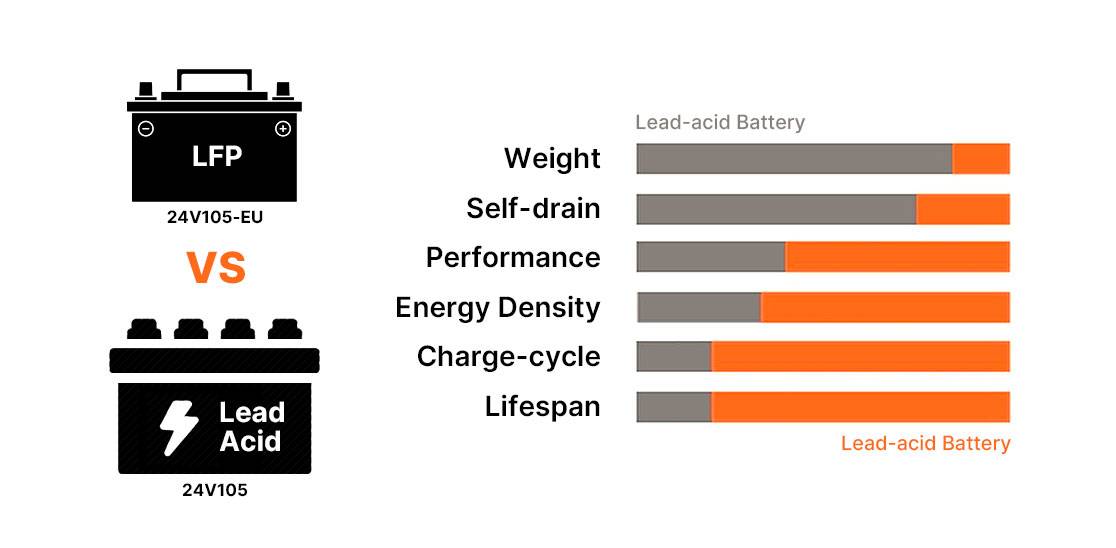
- Weight and Size:
- Lithium Battery: Lighter and more compact for the same energy capacity.
- Lead-Acid Battery: Bulkier and heavier.
- Energy Density:
- Lithium Battery: Higher energy density, allowing more energy storage in the same space.
- Lead-Acid Battery: Lower energy density.
- Cycle Life:
- Lithium Battery: Offers up to 4000 cycleswith 80-90% Depth of Discharge (DOD).
- Lead-Acid Battery: Limited to around 500 cycleswith 50% DOD.
- Charging Efficiency:
- Lithium Battery: Charges more efficiently, minimizing energy loss during charging.
- Lead-Acid Battery: Less efficient charging.
- Maintenance:
- Lithium Battery: Maintenance-free, reducing operational costs and hassle.
- Lead-Acid Battery: Requires periodic maintenance (water level checks, equalization charging).
In summary, lithium batteries excel in longevity, efficiency, and convenience, making them a preferred choice for various applications .
What quality standards should a 24V 105Ah-EU lithium battery fulfill during its manufacturing?
Manufacturing a 24V 105Ah-EU lithium battery involves adhering to critical quality standards:
- International Compliance: Follow ISO 9001 (quality management) and ISO 14001 (environmental management) regulations.
- Safety Certifications: Obtain UL or CE certifications to demonstrate adherence to safety and product standards.
- Rigorous Testing: Subject the battery to IEC 62133 tests to verify safety and prevent short-circuits.
- Stringent Processes: Implement consistent manufacturing processes.
- Quality Control: Monitor battery quality and performance at every production stage.
These practices ensure reliable performance and safety for users.
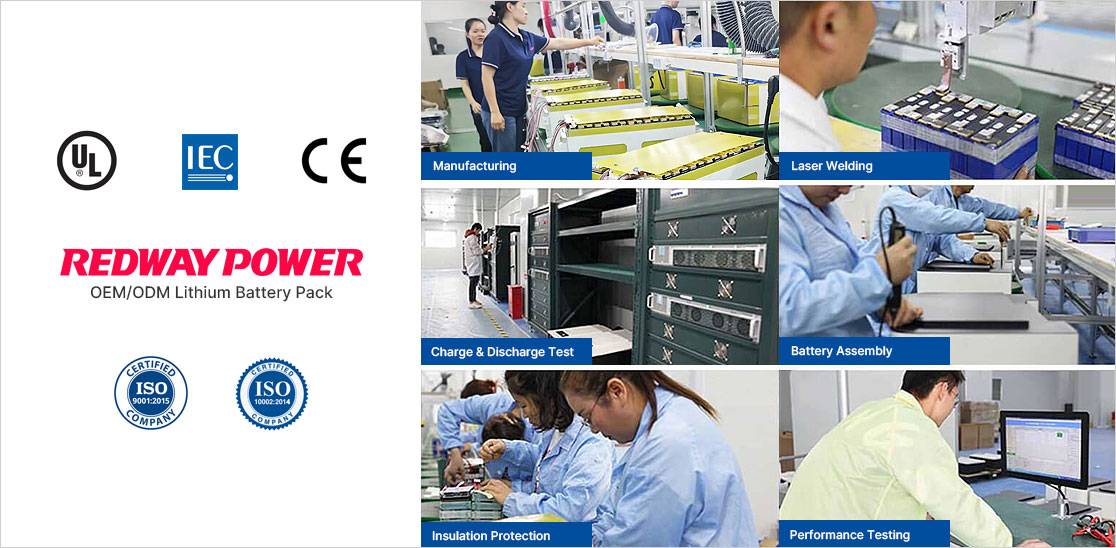
Is it safer to use a 24V 105Ah-EU lithium-ion battery in small size vehicles?
Yes, in compact vehicles, implementing a 24V 105Ah-EU lithium-ion battery can enhance safety as opposed to traditional lead-acid batteries. This is due to the stable chemistry and lower risk of leakage or spillage associated with lithium-ion batteries, making them a suitable choice for restricted spaces in smaller vehicle installations. Additionally, these batteries are equipped with built-in protection circuits that protect against hazards such as overcharging, over-discharging, and short circuits, minimizing potential safety concerns. Nevertheless, regardless of the battery type used, it is essential to carefully install, handle, and maintain it to ensure optimal safety and prevent accidents.
What are the features of a 24V 105Ah-EU lithium-ion battery?
This 105Ah-EU 24V Lithium-ion battery is lightweight, has a high energy density, and has a long cycle life. It is easy to charge, has a low self-discharge rate, and requires minimal maintenance.
What are the specifications of a 24V 105Ah-EU lithium-ion battery?
A 24V 105Ah-EU lithium-ion battery offers lightweight, high energy density, long cycle life, and requires minimal maintenance. Suitable for various applications, it ensures reliable energy storage.
How to maintain a 24V 105Ah-EU lithium-ion battery?
Proper maintenance is essential for maximizing the lifespan and performance of a 24V 105Ah-EU lithium-ion battery. Here are the key steps to effectively maintain your battery:
- Follow Manufacturer Guidelines:
- Adhere to all guidelines provided by the battery manufacturer. These instructions cover safe handling, charging, and usage.
- Proper handling prevents damage and ensures optimal performance.
- Regular Monitoring:
- Avoid leaving the lithium battery unattended for extended periods, especially during storage.
- Regularly check the battery status, including its charge level and any signs of degradation.
- Charge Before Storage:
- Although lithium batteries have a low self-discharge rate, it’s essential to charge or discharge them before extended storage periods.
- Storing a partially charged battery is better than storing it fully charged or completely depleted.
- Avoid exposing the battery to high temperatures during storage, as excessive heat can reduce its lifespan.
- Handle with Precaution:
- Protect the battery from excessive vibrations, shocks, and impacts. Secure it properly in its housing or mounting.
- Manage temperature: Avoid extreme cold or heat, as both can affect battery performance.
- Prevent overcharging: Use a suitable charger that prevents the battery from reaching excessively high voltages during charging.
In summary, following these maintenance practices ensures that your 24V 105Ah-EU lithium-ion battery remains in excellent condition, providing reliable power when needed.


